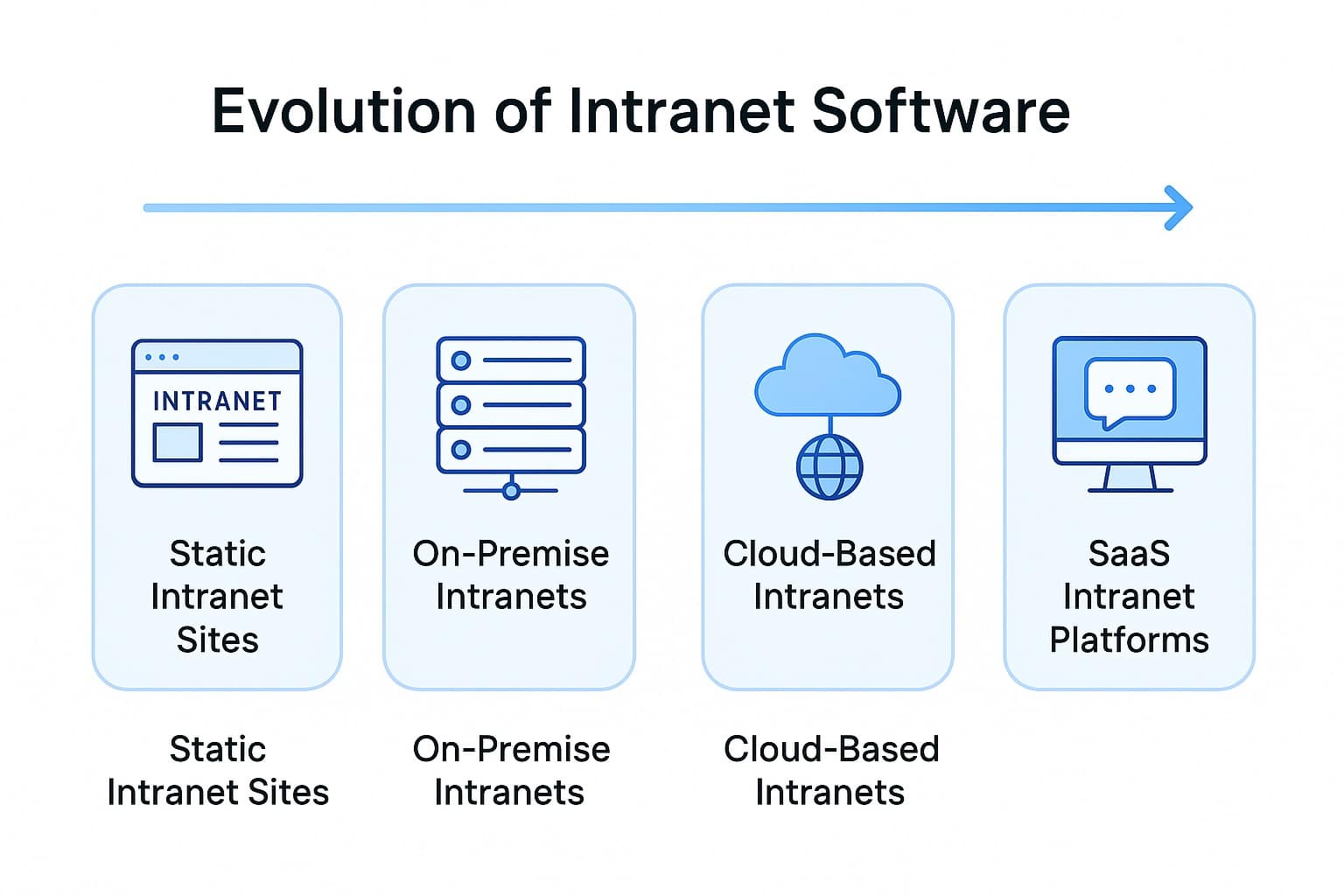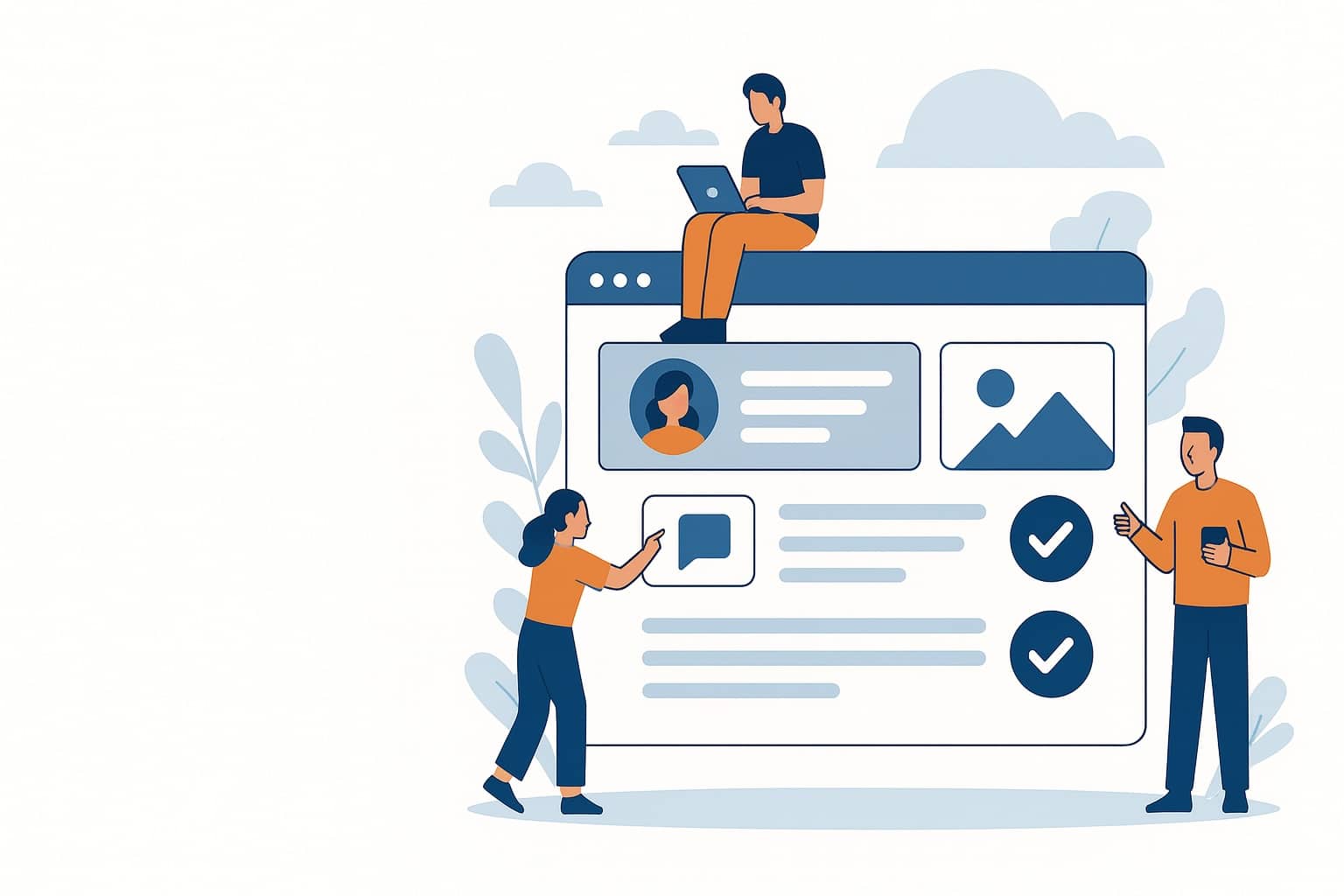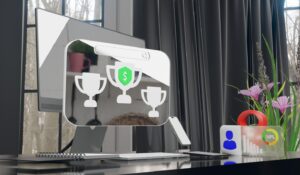A decade ago, an intranet was a dusty file cabinet on the web. In 2025, intranet software is your digital HQ – where employees read critical updates, find SOPs in seconds, collaborate with peers, recognize wins, and get personalized, AI-powered answers across web and mobile. Done right, a modern intranet solution lifts productivity, reduces comms chaos, and strengthens culture for both office and frontline teams.
This guide focuses on the foundations of intranet software: what it is, why it matters, the different types, key features, benefits, and how to evaluate solutions. For vendor comparisons of the best intranet software platforms and top intranet platforms, see our dedicated article on Best Intranet Software Platforms in 2025 (Top Enterprise & Company Solutions).
👉 Want the short version? See our employee intranet platform for a hands-on look.
What Is Intranet Software?
Intranet software is a secure, private digital environment where employees communicate, collaborate, and access company knowledge. It centralizes news, policies, files, conversations, and apps—so people spend less time hunting and more time doing. Many organizations now refer to this as a digital workplace intranet because it connects tools, people, and processes in one place.
At a glance, a modern intranet typically includes:
- Communications hub: news, newsletters, targeted announcements, read receipts.
- Knowledge & search: wikis, SOPs, policies, versioned docs, AI-powered search.
- Engagement & community: recognition, social feeds, comments, surveys, and gamification.
- Workflows & integrations: forms, approvals, automation, SSO, HRIS/LMS/IDP connectors.
- Mobile-first access: native apps for deskless and multilingual teams.
Intranet vs. Extranet vs. Internet
- Internet: public and open to everyone.
- Intranet: private to employees.
- Extranet: private but shared with selected third parties (partners, vendors).
👉 Deeper dive: Intranet vs Extranet vs Internet. Also see how content flows with effective intranet communications.
Evolution of Modern Intranet Solutions
Intranets have evolved significantly:
- Static intranets: hosted on-premise, limited to file storage.
- Document-heavy intranets: SharePoint and ECMs focused on compliance.
- Modern intranet solutions: cloud-based, integrated with apps, social, and AI-driven.
This evolution is why organizations now choose cloud intranets (cloud intranet) and digital workplace intranets that integrate with Teams, Slack, and HR systems.
📊 According to McKinsey, connected employees drive 20–25% more productivity. This stat underscores why digital workplace intranets have become critical in hybrid and frontline environments (McKinsey).

Types of Intranet Solutions
| Type | Description | Pros | Cons | Best For | Key Features |
|---|---|---|---|---|---|
| Legacy Static | CMS-style sites (WordPress, Drupal) | Low cost, easy setup | One-way, stale content, limited analytics | Very small orgs needing simple publishing | Basic pages, file hosting |
| Document-Centric | SharePoint/ECM with workflows | Compliance, versioning, permissions | Complex UX, IT-heavy, costly | Regulated industries, large enterprises | Document libraries, workflow automation, permissions |
| Modern Dynamic | Cloud, social, AI, mobile | Personalized feeds, social, multilingual, integrations | Subscription cost, requires adoption planning | SMBs to global enterprises | AI search, targeted comms, recognition, gamification, analytics, mobile apps |
👉 Explore: company intranet software, employee portals, intranet portals.
Benefits of Modern Intranet Platforms
A modern intranet application is more than a news site—it’s an operating layer for how work gets communicated and done.
- Productivity & Focus: Gartner estimates employees spend 2.5 hours/day searching for information (Gartner). Intranets cut that dramatically.
- Stronger Communication: Targeted news, safety alerts, crisis updates, and leadership messages ensure alignment. Edelman also reports that transparent internal communication builds higher employee trust (Edelman Trust Barometer).
- Engagement & Culture: Gallup found engaged teams are 21% more profitable (Gallup). Social features, recognitions, and gamification boost morale.
- Frontline Reach: Deloitte reports that 52% of frontline employees would consider leaving if workplace tech is poor (Deloitte). Mobile-first intranets reduce this risk.
- Scalability & Governance: Role-based permissions, templates, and analytics scale from SMBs to enterprises.
👉 Explore more use cases in intranet for companies, intranet communications, and employee engagement activities and ideas.
Core Features of Modern Intranet Applications
A well-rounded enterprise intranet solution should cover:
- Employee portal: a central hub for tools and resources (employee portal)
- Knowledge & collaboration: wikis, pages, commenting, and ownership
- Targeted communications: newsletters, campaigns, and required reads
- Social intranet features: recognition, gamification, communities (social intranet platforms)
- Multilingual intranet software: deliver content globally with auto-translation (multilingual intranet software)
- AI integration: smart feeds, semantic search, automation (AI-powered workplaces)
- Intranet search engine: fast, AI-driven search across policies and content (intranet search engine)
- Analytics: dashboards on content reach, queries, and engagement
- Integrations: SSO, HRIS, Microsoft 365, Google Workspace, Teams, Slack (intranet apps)
- Governance & security: compliance, permissions, and retention (intranet security)
- Cloud-based deployment: scalable, accessible solutions (cloud intranet solutions)
Checklist: Must‑Have Intranet Features in 2025
- Mobile-first UX
- Multilingual authoring + auto-translation
- AI search + personalized feeds
- Audience targeting
- Forms, workflows, acknowledgments
- Recognition + gamification
- Open APIs and prebuilt integrations
- Analytics dashboards + governance
👉 See more from intranet providers.
Employee Intranet Software: How It Helps Companies
Employee intranet software creates consistent experiences across roles and industries:
- SMBs: consolidate tools, launch fast.
- Mid-market: unify corporate and frontline comms.
- Enterprise: integrate HRIS/LMS, support multilingual compliance.
- Healthcare: digital adoption improving patient outcomes (HIMSS).
- Manufacturing: effective safety communication reduces incidents by 30% (OSHA).
- Retail/logistics: strong communications reduce turnover by 25% (SHRM).
👉 Related reads: navigating your staff portal, workplace communications.
👉 Explore: HubEngage’s employee intranet platform.
Social Intranet Platforms for Employee Engagement
A social intranet platform transforms passive readership into active participation:
- Recognition and kudos build momentum.
- Communities connect people beyond org charts.
- Conversations surface frontline insights.
With Gen Z already 30%+ of the workforce and 70% expecting social tools (Deloitte), social intranets mirror consumer apps. Companies using them see 2x higher participation and 40% more recognition activity.
👉 Deep dive: Social Intranet Platforms
Best Intranet Websites for Inspiration
Strong intranet design is clear, fast, and purposeful:
- Clarity: scannable cards, plain language.
- Findability: smart search across acronyms.
- Personalization: feeds tailored by role.
Legacy/SharePoint intranets require manual layouts; modern intranets provide dynamic feeds that reduce design overhead. Poor usability can cut productivity 20–40% (Nielsen Norman Group).
👉 Browse examples: Best Intranet Websites
How to Choose the Right Intranet Solution
Framework for evaluation:
- Define outcomes: tie goals to measurable results.
- Inventory content & channels: include compliance + integrations.
- Assign governance: clarify owners and roles.
- Pilot & adoption: test with champions.
Pro tip: Intranet success requires IT + Communications co-ownership.
👉 For vendor rankings and comparisons, see our dedicated cluster page: comparison of best intranet platforms.
Future of Intranet Software (AI & Beyond)
Intranets are evolving into digital workplace assistants:
- Predictive search & instant answers
- Generative content authoring
- Signal-driven targeting across push, Teams, Slack, WhatsApp
- Unified analytics tied to business outcomes
- AI-driven personalization and automation for every employee role (AI-powered workplaces)
Conclusion
Modern intranet software unifies communication, knowledge, and culture. This guide covered definitions, types, features, and benefits of intranet solutions and the digital workplace intranet. For a detailed vendor comparison of the best intranet software platforms and top intranet software, head to article on Best Intranet Software Platforms in 2025.
👉 See the HubEngage employee intranet platform in action today.
FAQs
What is intranet software?
Intranet software is a secure, private digital platform where employees access company news, policies, documents, and tools. A modern intranet also enables collaboration, recognition, and knowledge sharing across web and mobile, making it the central hub of the digital workplace intranet.
What are intranet platforms used for?
Organizations use intranet platforms to streamline communication, connect employees, and centralize resources. They help reduce silos, improve compliance, and boost productivity by keeping everyone aligned. In short, an intranet solution serves as the operating layer for daily employee engagement and workplace efficiency.
What are examples of intranet solutions?
Examples of intranet solutions include company intranet software, employee portals, social intranet platforms, and secure cloud intranets. Each supports specific needs—from document storage and communication to engagement and collaboration. Together, these modern intranet applications form the backbone of today’s digital workplace.
What features should modern intranet software include?
A modern intranet should include mobile-first access, AI-powered search, multilingual support, secure role-based permissions, analytics dashboards, recognition and social features, and integrations with tools like Teams, Slack, and HR systems. These features ensure an intranet platform is engaging, scalable, and future-ready.
How do intranet platforms differ from employee portals?
An intranet platform is a comprehensive workplace hub that unifies communication, knowledge, and culture, while an employee portal typically focuses on HR self-service tasks such as payroll, leave requests, or benefits. Many modern intranet solutions now combine both, offering a single employee experience.
Is intranet software the same as a digital workplace intranet?
Not exactly. Traditional intranet software mainly hosted documents and announcements. A digital workplace intranet goes further by integrating communications, apps, workflows, and AI personalization into one solution, making it more interactive, mobile-friendly, and essential for hybrid and frontline workforces.
Related internal links for deeper exploration:
• Intranet Communications: How Companies Connect in 2025
• Intranet vs Extranet vs Internet: Definitions, Differences & Examples
• Maximize Your Company Intranet Software Rollout With These 7 Tips
• Employee Portal: The Complete Guide to Staff & ESS Portals, Software & Apps
• Intranet Portal: The Digital Front Door to Your Organization
• Multilingual Intranet Software with Auto-Translation for a Global and Diverse Workforce
• AI Powered Workplaces with Smarter Solutions for Businesses
• Best Intranet Software Platforms in 2025 (Top Enterprise & Company Solutions)
• Social Intranet: The Future-Proof Platform to Engage & Retain Your Workforce
• Intranet Search Engine: AI-Powered Internal Search for Companies
• Best Intranet Websites & Examples: For Enhanced Internal Communication
• Intranet Apps: The Best Mobile Intranet Apps for 2025
• Choosing the Right Intranet Provider: Complete Guide for 2025
• Cloud Intranet: Definition, Benefits, Comparisons & Best Software
• Intranet Security: How to Build a Secure Intranet Platform in 2025













